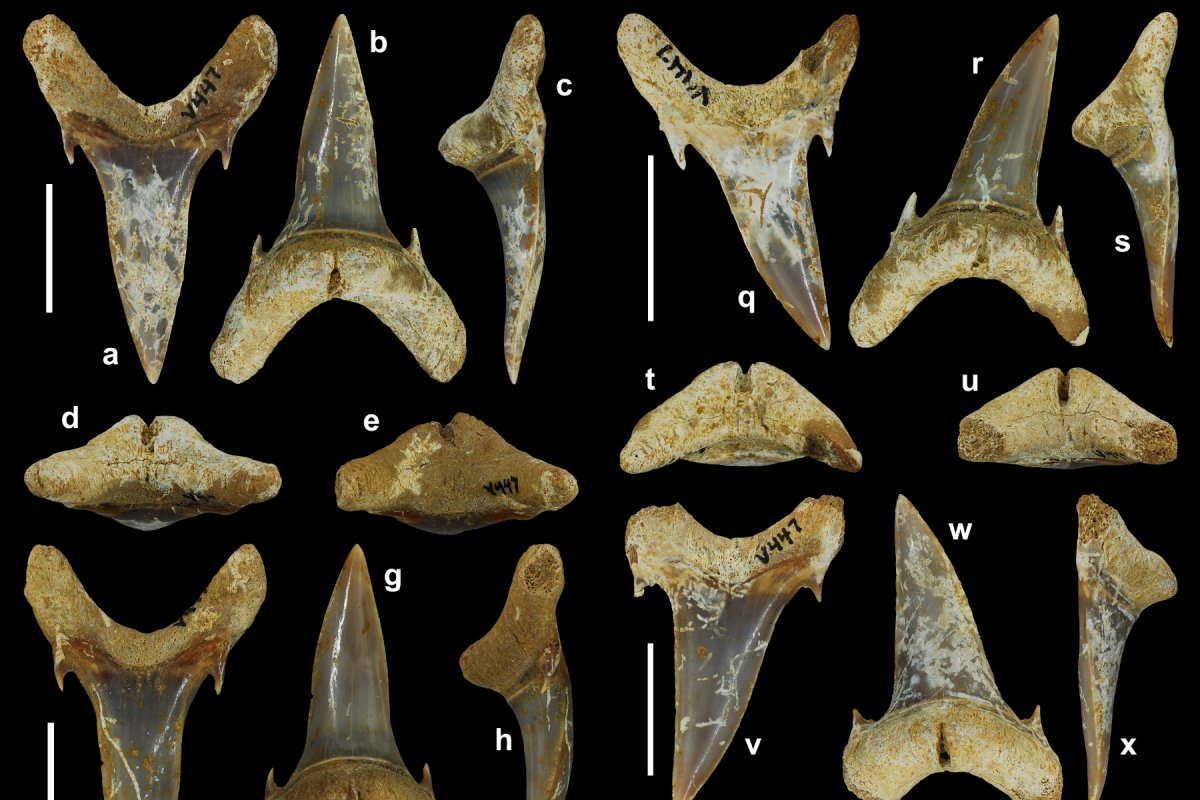A brand new species of prehistoric shark has been discovered, and its teeth have a terrifying addition: their very own tiny fangs.
The shark has been named Palaeohypotodus bizzocoi. Its genus name Palaeohypotodus roughly translates to "ancient small-eared tooth." The fossilized teeth have tiny protruding pieces on either side of the main tooth, resembling vampire fangs.
This shark species is thought to have been a predator that ruled the seas just after the dinosaurs were wiped out by the Chicxulub asteroid impact, according to a new paper in the journal Fossil Record.

"In this study, we documented a new species of 65-million-year-old fossil shark, named Palaeohypotodus bizzocoi, that lived during a geological stage called the Paleocene," paper co-author Jun Ebersole, the director of collections at the McWane Science Center in Birmingham, told Newsweek.
"This is the geological stage that directly followed the extinction of the dinosaurs when 75 percent of life on Earth went extinct. Sharks like P. bizzocoi give us insights into how marine life responds and recovers from cataclysmic events," Ebersole said.
This was the last mass extinction event that Earth faced, known as the Cretaceous–Paleogene extinction, and resulted in the death of the dinosaurs, pterosaurs, and many mammals, insects, reptiles, amphibians and birds. The seas were also hit badly by extinctions, with marine reptiles like mosasaurs and plesiosaurs being wiped out, as well as invertebrates like ammonites. Seven percent of all families and 50 percent of all genera were wiped out: for reference, humans are in the Hominid family and the Homo genus.
During this period, much of what is now Alabama was underwater, covered by a shallow tropical ocean. In the absence of previous apex predators like marine reptiles, sharks like this new species would have flourished.
"This shark absolutely benefited from the extinction of marine reptiles (like mosasaurs) and larger predatory sharks that lived during the time of the dinosaurs. After the dinosaur extinction event, P. bizzocoi was one of the larger sharks that swam in the oceans in this region and was very likely one of the top marine predators during the time," Ebersole said.
The new species was accidentally discovered from a sample of these strange teeth, which had been hidden in a box filled with other shark teeth collected from the lower Paleocene (Danian) Porters Creek Formation in Wilcox County, Alabama over a century ago.
"A few years ago, I was looking through the historical fossil collections at the Geological Survey in Alabama and came across a small box of shark teeth that were collected over 100 years ago in Wilcox County," Ebersole said in a statement. "Having documented hundreds of fossil fish species over the last decade, I found it puzzling that these teeth were from a shark that I didn't recognize."
The researchers investigated these strange new teeth and found that they didn't match any known species, living or extinct.

The species was named P. bizzocoi in honor of Alabama archaeologist Bruce Bizzoco. The researchers hope to find even more fossil fish and shark species, furthering the rich fossil record of the area.
"Discovering a new fossil species is never a common occurrence, but here in Alabama, we are discovering a number of new species every year. Alabama is a global hotspot for marine fossils extending back nearly 500 million years, but much of our rich fossil record has never been studied," Ebersole said.
"In just the past decade alone, I have collaborated with scientists from around the world to document many of the vertebrate species from Alabama, which included a new species of dinosaur, mosasaurs, several marine turtles, and numerous sharks, rays, ratfishes, and bony fishes.
"The fossil record in Alabama is so rich, that I will likely spend the rest of my career just studying the fossil fishes," Ebersole said. "There are entire time periods in the state that have never been studied that are chalked full of fish fossils—many of which represent new records for this region or are entirely new to science. In fact, currently in my lab, I have a backlog of at least six to ten new species that are waiting for me to document and name in the scientific literature."
Do you have a tip on a science story that Newsweek should be covering? Do you have a question about fossils? Let us know via science@newsweek.com.
Update 2/8/24, 1:30 p.m. ET: This article was updated with comment from Jun Ebersole.
Uncommon Knowledge
Newsweek is committed to challenging conventional wisdom and finding connections in the search for common ground.
Newsweek is committed to challenging conventional wisdom and finding connections in the search for common ground.
About the writer
Jess Thomson is a Newsweek Science Reporter based in London UK. Her focus is reporting on science, technology and healthcare. ... Read more
To read how Newsweek uses AI as a newsroom tool, Click here.





